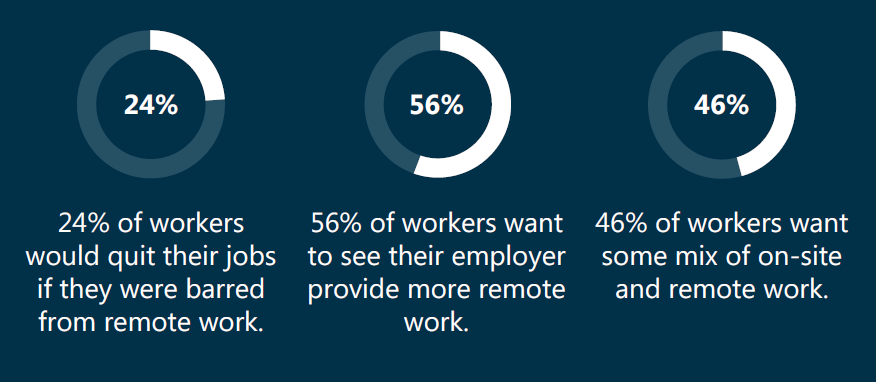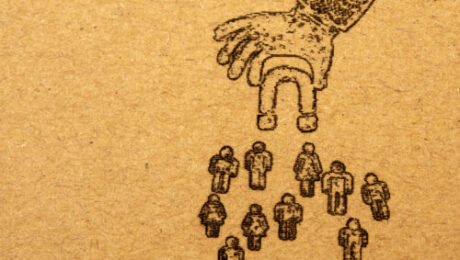How Employers Are Shifting Strategies as Recruitment and Retention Struggles Continue
This article is from RISQ Consulting’s Zywave client portal, a resource available to all RISQ Consulting clients. Please contact your Benefits Consultant or Account Executive for more information or for help setting up your own login.

Workplace dynamics have significantly changed in the last few years. Employers have been forced to respond to increasing worker demands for workplace flexibility, well-being initiatives and inclusive cultures. In addition, workers are becoming more vocal about management styles they are no longer willing to tolerate. This has resulted in many employers continuing to struggle to attract and retain talent. To address these struggles, many organizations have started altering their approach to workforce attraction and retention.
This article discusses current recruitment and retention trends and provides several strategies employers are using to help address and overcome such struggles.
Recruitment and Retention Struggles Continue
Employers continue to grapple with recruitment and retention struggles due in large part to changing employee preferences. According to a recent study by Willis Towers Watson, 83% of employers reported difficulty attracting employees, while 74% reported difficulty retaining employees. These are the highest figures in the past 12 years. Many organizations are still dealing with the lingering impact of the COVID-19 pandemic, which reshaped workers’ expectations, including where and when they work. This has forced many organizations to adapt their recruitment strategies.
Moreover, the tight labor market increased competition among employers for key talent, pressuring organizations to offer attractive compensation and benefits packages. Despite these efforts, nearly 75% of employers are experiencing talent shortages and difficulty hiring, according to a 2023 survey by global workforce solutions company ManpowerGroup. As these trends persist, employers’ recruitment and retention struggles continue. This is forcing employers to develop new and innovative approaches to address these challenges.
Employees Are More Selective in Where They’re Willing to Work
Workplace environments and management approaches are impacting where employees choose to work, according to a recent survey by online employment solution company Monster. The survey results revealed that certain employment practices and behaviors create anxious or negative feelings among employees, which employees consider red flags. The survey also found that the biggest employee concern is being micromanaged by supervisors and managers. Other red flags included:
- Excessive meetings
- Inflexible work hours
- Team bonding exercises or out-of-office events
- Mandatory assignments during the interview process
- Inability to negotiate benefits
Awareness of these concerns can allow employers to evaluate whether any red flags are present in their organizations and make necessary changes to improve their recruitment and retention efforts.
Strategies to Address Recruitment and Retention Struggles
Due to these ongoing struggles, many employers are responding with multiple strategies as well as focusing on emotional intelligence in their attraction and retention efforts. This is leading many organizations to shift to taking a holistic approach to attracting and retaining workers by focusing on customizable benefits, positive work environments and meaningful work assignments and duties.
Employers can consider the following strategies as they respond to their ongoing recruitment and retention struggles:
- Prioritize onboarding. Employees who go through a structured onboarding are 58% more likely to remain with the organization after three years, according to a study by the Wynhurst Group. By including onboarding in an organization’s overall engagement and retention strategy, employers can better communicate their values, foster a positive relationship and communicate expectations to set employees up for success. Onboarding is also an opportunity to educate employees on the full range of available benefits, ensuring that employees are aware of all the benefits available to them.
- Create meaningful connections. Making sure employees have meaningful workplace connections can help employees feel supported and valued. It also tends to increase workers’ loyalty and commitment to an organization. Employers can do this when new employees join the organization by assigning mentors, scheduling regular check-ins and organizing team-building activities.
- Utilize employee engagement surveys. Employee feedback can be a valuable resource for employers to understand their workforce. Surveys can uncover underlying issues, such as decreased productivity or high turnover rates, and create actionable change that drives progress within an organization. Employers who effectively utilize employee surveys may see many benefits, such as increased employee engagement, job satisfaction and retention.
- Train managers and supervisors. Managers can significantly impact employee engagement, job satisfaction and productivity, and retention. When managers lack important interpersonal skills or emotional intelligence, they can contribute to high rates of turnover. Organizations can train managers to have strong interpersonal skills (e.g., connection, honesty, respect and communication) so they can better recognize and respond to employee needs.
- Improve workplace culture. Toxic workplace culture is the top reason employees quit their jobs, according to a recent survey by employment website FlexJobs. When employees feel overworked and underappreciated, they’re more likely to look for new opportunities. Employers can create a positive and healthy workplace culture by promoting mental health and well-being and fostering open and transparent communication.
Takeaway
Employers who successfully address the reasons employees choose not to accept job offers or quit their jobs will likely experience less time to fill open roles and reduced employee turnover rates. This can help organizations reduce hiring costs, improve employee morale, and give a competitive advantage over similar organizations that are unable to address their ongoing recruitment and retention challenges.
For more workplace resources, contact RISQ Consulting today.
- Published in Blog
U.S. Adds Over 500,000 Jobs in January
This article is from RISQ Consulting’s Zywave client portal, a resource available to all RISQ Consulting clients. Please contact your Benefits Consultant or Account Executive for more information or for help setting up your own login.

The U.S. Bureau of Labor Statistics (BLS) found in its January jobs report that the United States added an astonishing 517,000 nonfarm jobs in January, indicating that the labor market is not cooling down. January’s added jobs were above December’s gain of 260,000 and the Dow Jones estimate of 187,000 jobs to be added this month. They were also higher than 2022’s average monthly gain of 401,000—a year that had strong job growth—and the largest increase since July 2022. The largest gains were in leisure and hospitality, professional and business services, and health care.
The unemployment rate fell from 3.5% in December to 3.4% in January. This is the lowest rate since May 1969. Experts expected the unemployment rate to increase to 3.6% in January. The labor force participation rate edged up from 62.3% in December to 62.4% in January, the highest rate since March 2022. However, the current labor force participation rate is still well below pre-pandemic levels of 63.4%. A larger labor supply helps ease a tight labor market and puts downward pressure on wages since there’s less competition among employers for candidates.
Despite January’s stronger-than-expected jobs report, wage growth came in as expected at 0.3%. January’s report also revealed that wage growth moderated on an annual basis. Wage growth has now slowed to 4.4% after reaching its peak of 5.9% in March 2022.
In January, individuals worked, on average, 34.7 hours a week, up from 34.4 in December. This is the most since March 2022, signaling that the demand for workers will likely persist for the foreseeable future.
Employer Takeaways
January’s surprising jobs report comes as the Federal Reserve (Fed) continues to increase interest rates in an attempt to fight inflation, cool the labor market and ease pressure on wages. The Fed has raised its benchmark interest rate eight times since March 2022. This month’s report indicates that the job market is currently stronger and more resilient than expected; however, economists think that January’s job gains may be influenced by seasonal factors and the early year job and wage environment.
January’s numbers cast doubt on concerns that the U.S. economy is in a recession or approaching one. While this month’s jobs report indicates that the labor market is stronger than previously believed, wage growth is slowing, potentially easing pressure on employers to increase wages to attract talent. However, since the labor market is still not cooling down, employers’ struggles to attract and retain workers will likely continue for the foreseeable future. As such, employers should continue to monitor employment trends to stay competitive in today’s evolving market.
Contact RISQ Consulting for more resources.
- Published in Blog
The Great Reconsideration: Looking Ahead to the Next Stage of the Labor Market
This article is from RISQ Consulting’s Zywave client portal, a resource available to all RISQ Consulting clients. Please contact your Benefits Consultant or Account Executive for more information or for help setting up your own login.
The labor market continues to be unpredictable and driven by new challenges. As such, economists have signaled that the labor market is moving into another phase. Previously, there have been trends labeled as the Great Resignation and the Great Reshuffle. The Great Resignation referred to a mass movement of workers leaving the workforce. In contrast, the Great Reshuffle illustrated workers quitting one job they are unsatisfied with to take another—which has been a more accurate assessment. There has not been a mass exodus from work itself, as the term the Great Resignation suggested. While these terms still hold some truth to the current state of the market, some economists have even used a new term to describe the current worker sentiment: the Great Reconsideration. Instead, workers are seizing the unprecedented opportunity to reconsider and change their work experiences. They’ve had time to reflect on their jobs and consider opportunities with a fresh perspective.
This article examines the current labor market, highlights driving trends and offers tips for employers navigating the market.
Market Overview
The most recent U.S. Bureau of Labor Statistics (BLS) report revealed that the number of job openings rose to 11.2 million in July. This number was well above the estimate and still outnumbered unemployed workers by about 5.5 million. The July BLS numbers reinforced that there is still a considerable shortage of workers for available positions, with openings outnumbering available workers by a nearly 2-to-1 margin.
Employee quits, a top worker confidence metric, dropped from a record-high 4.53 million in March to 4.18 million at the end of July. The report also revealed that the employee quit rate declined one tenth of a percentage point to 2.7%. Nonetheless, this number is still relatively high by historical standards.
Additionally, the unemployment rate has not yet reached pre-pandemic levels. In July, the rate sat at 3.7%. In a regular labor market, this could be a troubling sign; however, it indicates that the job market could be on its way to normalizing. From a retention and attraction perspective, these numbers further illustrate that it’s a worker-friendly market.
The struggle to fill positions and related challenges have increased labor costs for employers as they raise wages and offer competitive benefits and other perks to attract talent. The market trends also demonstrate that workers remain confident enough to switch jobs for better pay and working conditions despite economic pressures like inflation.
Driving Trends
The COVID-19 pandemic undoubtedly shifted the playing field for workers and organizations. Now, amid the Great Reconsideration, both parties are reevaluating various aspects of the workplace and the workday.
Many employers are reassessing what workplace accommodations or transformations have—or have not— worked and what can be done to improve employee engagement and satisfaction. Simultaneously, workers are reconsidering their career goals and expectations for an employer.
Hybrid Work
Hybrid work continues to be a catalyst for modern workplace challenges. As such, more on-site workers want to leave their jobs than remote workers, according to a survey from professional services network KPMG. Consider the following additional statistics:

Many workers desire a hybrid workplace model to have more face-to-face time with their co-workers. The camaraderie with colleagues is a top reason why workers want to be in the office or similar settings part-time. Other motivators include creating a work-life balance, getting out of the house or benefiting from a regular change of environment. In the end, workers are looking for solid and united company cultures—and employers have an opportunity to act on this desire as they reconsider their workplace expectations and strategies. Employers who embrace hybrid work models may see improvements in employee productivity, morale and, most critically, retention.
Long COVID and the Labor Market
Long COVID-19—long-term effects stemming from COVID-19 infection—continues to impact the labor market and employees’ health. The U.S. Census Bureau’s latest Household Pulse Survey found that 16.3 million working-age Americans currently have long COVID. It has been reported that long COVID is even keeping some workers out of employment; an estimated 4 million workers are out of the labor market, according to Brookings Institution’s nonresident senior fellow Katie Bach.
Long COVID can pose serious risks for employers, including decreased productivity and the loss of employees from the workforce entirely. Therefore, they must stay up to date on trends surrounding the condition’s rates and other related topics, such as strategies other employers are using to respond to long COVID.
Salaries and Job Hopping
HR services provider ADP reported that salaries have been increasing rapidly, nearly on par with inflation. Annual pay raises rose by 7.6% in the period leading up to August 2022, compared to an average of 2% in early 2021. However, the most significant raises went to job hoppers. Those who found different jobs experienced salary gains of 16.1%, while employees who stayed loyal to a company received an average increase of 7.6%.
Looming Recession
As the Federal Reserve struggles to tame skyrocketing prices, employers and employees alike are worried about entering a recession. Some might even say a recession has already begun. The reality for many business owners due to the employment market is slower growth and rising labor costs. As a result, many organizations have experienced or are planning layoffs and hiring freezes in the back half of this year.
What Are Employers Doing?
Although the Great Reconsideration is currently taking place, new labor challenges will likely surface. All employers can do is face the moment and put together a game plan. As a thought-starter, here are strategies some organizations are using to win over talent:
- Review compensation. As employers and employees continue to be hit by inflation, organizations should start reviewing and assessing their current compensation and benefits. It could be helpful to analyze pay raises from similar companies based on industry or geographic location.
- Reimagine company culture. Just as workers are reconsidering what they want for work and an employer, an organization can reevaluate its goals and what kind of employer they want to be. Company culture can be an organization’s best protection against losing employees—and offer a leg up on attracting new employees. There is usually a gap between organizational leadership and what employees experience, so there’s a need to keep it aspirational but realistic.
- Rethink perks. Flexibility is no longer a generous workplace perk. It’s a significant perk, but many employees already have a flexible working schedule or expect it from prospective employers. With remote or hybrid work becoming table stakes, employers will have to stand out against the competition with other unique perks (e.g., four-day workweek and flexible hours).
- Prioritize real-time over real-life connections. Workplace connection has often been thought of as something that happens during the workday in the hallway, at the coffee station or in other communal areas. However, employers can still plan for real-life connections without requiring employees to be working on-site all day. This can be achieved by making real-time communication a habit for employees by providing tools, opportunities and encouragement to connect. Employers are considering ways to create intentional spaces for peer connection that don’t necessarily involve day-to-day work.
- Invest in career growth. With many workers reevaluating their career goals and paths, employers can invest in workers by expanding learning and development opportunities. Employers can enhance their staffing and worker skill levels by offering employees a chance to enrich their careers via upward mobility. Forward-thinking organizations will plan to recruit and retain employees for the skills needed today—and in the future.
In the end, many employers are reinventing their company culture to account for adjusted organizational mission and values, company culture and employee expectations.
Summary
Generally, job openings remain high as the demand for workers outweighs the supply. Many employers are at a disadvantage and struggling to fill positions. Unfortunately, experts expect talent challenges to continue. Yet, forward-thinking organizations are benefiting when they remember that workers are human. Workers are looking for an employer who matches their style, needs and beliefs. They want to work where they feel care and support from their employers. As the Great Reconsideration is in progress, employers will have to find ways to make their culture and workplaces look and feel authentic and reliable. Employers should continue to monitor employment trends in the evolving market to stay competitive. Contact us for more resources.
- Published in Blog
Understanding the “Quiet Quitting” Trend
This article is from RISQ Consulting’s Zywave client portal, a resource available to all RISQ Consulting clients. Please contact your Benefits Consultant or Account Executive for more information or for help setting up your own login.
“Quiet quitting” is an emerging trend where workers only do what their job description entails without going above and beyond. Over the course of the COVID-19 pandemic, many employees shifted their views on their work lives, and this has been reflected in movements such as the Great Reshuffle—a mass movement of workers to jobs that meet their demands for things such as more flexibility and better benefits—the shift to remote work and, now, the quiet quitting trend.
Employees who solely complete their job description and no more could continue to be valuable workers. However, employers can consider steps to engage employees and prevent quiet quitting from happening in the first place. To help eliminate the trend’s presence in their organizations, employers should focus on effective communication with their employees and methods to enhance employee engagement.
Signs of Quiet Quitting
Research conducted by Gallup found that only 32% of employees are engaged, and 17% are actively disengaged. Employees who are not engaged could be at risk for doing only their job and not going above and beyond. Further, 53% of workers reported they feel burnt out, according to Talkspace’s Employee Stress Check 2022 Report. To improve employee engagement and prevent these issues from turning from quiet quitting into actual quitting, employers need to know what signs to look for. Employers should pay attention to employees who are consistently doing the following:
- Not attending meetings that are not mandatory
- Not being as productive as they once were
- Contributing to team projects less
- Not participating in meetings
- Displaying a lack of enthusiasm
It is important to know that there a several reasons an employee may choose to quiet quit. For example, they may simply refuse to do work outside their job description because they feel they are not being compensated for it. While it may not be clear why an employee is choosing to quiet quit, these signs are a good indicator that an employee may be thinking about it or trying to do so.
What Employers Can Do
Quiet quitting is often the result of decreased motivation and burnout. Further, a lack of effective communication between leaders and employees and a general failure of management and organizations can play a role. For example, failures may include a lack of honesty with employees and not delivering on promises. Consider the following ideas to help improve employee engagement and decrease the odds of quiet quitting among employees:
- Provide clear job descriptions. Job descriptions let employees know exactly what is expected of them. Employers should review job descriptions to ensure they accurately reflect the duties they expect their employees to perform.
- Conduct performance reviews. Performance reviews are opportunities to reward employees for the positive things they have done and inspire them to continue working hard. Without this feedback and indications of appreciation for hard work, such as title adjustments and salary raises, employees could lack motivation and start to feel burnt out and consider quiet quitting. Further, it is important to recognize employees who go above and beyond because they are likely to feel discouraged and decrease their performance if their contributions go unnoticed. Conversely, performance reviews are just as important for underperforming employees because they are opportunities to clearly communicate expectations and work together to correct the behavior.
- Educate employees on employee handbooks. Employee handbooks are another tool employers can use to clearly communicate expectations to employees, but they are only truly effective if employees understand them. Employers should take time to educate employees on their handbook and its policies so they can ensure employee understanding. The handbook should be reviewed and updated regularly to ensure that expectations are up to date and that organizations are in compliance with current laws.
- Provide learning and development opportunities. High employee engagement is crucial to preventing quiet quitting. One effective way to increase engagement is through learning and development initiatives. According to Zywave’s 2022 Attraction and Retention Benchmarking Overview, 29% of employers found career development opportunities to be a top priority of workers during the hiring process. Employees who have these opportunities are more likely to remain engaged and stay motivated to try their best at their jobs.
- Focus on good management strategies. Effective management is essential to having efficient, happy employees, so it is important to focus on the techniques managers use. Provide resources to managers about effective strategies and meet with them to discuss ways they can improve. Further, consider conducting skip reviews, where employees talk with their manager’s manager to discuss feedback or concerns they may have. This will allow the manager to receive helpful feedback that can be mutually beneficial and improve their employees’ experiences.
Takeaway
Quiet quitting is the new term for the trend of employees doing only what their job requires without exceeding expectations. Employers should be aware of the trend and that it will impact every workplace differently. Employers should monitor for signs that employees may be disengaging and utilize different strategies to help prevent quiet quitting. In cases where quiet quitting may be negatively impacting the employer and they cannot seem to resolve the issue, employers should ensure compliance with federal and local employment laws before pursuing any termination action. For specific guidance about disciplining employees, employers are encouraged to seek local legal counsel.
Contact RISQ Consulting today for more information on workplace trends, employee retention and employment laws.
- Published in Blog
Expectation vs. Reality – The Digitization Dilemma
By Andrew Kupperman, Employer Services and Workforce Technology Consultant
When an Employee starts working with an Employer, there are a variety of different expectations that go into forming that Employee/Employer relationship. For example, the Employer is going to expect the Employee to show up to their job and do the work asked of them. Correspondingly, the Employee is going to expect to be compensated for the work that was asked of them. These are the basic expectations at the heart of every Employee/Employer relationship, but they set a very important tone for all other expectations derived from this ongoing relationship.
Additional relationship building expectations include the Employer providing the Employee the tools, resources, and training to be able to do the work that is asked of them. In many organizations, one tool in particular – technology – often creates friction in the Employee/Employer relationship. There are a lot of reasons why this occurs.
CAPABILITIES
Workplace technologies don’t typically have comparable capabilities to the technology we all use daily in our personal lives. In fact, when looking at some capabilities in workplace technology, you could probably go back 5, 10, or even 15 years to see those capabilities being released for personal use. Don’t get me wrong, I know there are thousands (yes thousands) of technology vendors trying to close this gap for workplace technology, but because these gaps still exist, there is a gap that exists in what the Employee expects from their Employer, which can strain the relationship. This is especially true for younger workers just entering the workforce.
BRIGHT SHINY OBJECT SYNDROME
More often than I’d personally like to see, organizations decide to purchase and implement new technology just because of a cool demo someone saw. A word to the wise: the demo isn’t how your organization is going to receive that technology out of the gate – it needs to be built and implemented in order to eventually get there.
If you’ve ever seen Jason Averbook speak (the CEO and Founder of Leapgen, an organization that consults around workforce technology with Fortune 500 and very large global organizations as well as a thought leader in workforce technology space), he often discusses the difference between implementing technology and an organization successfully digitizing its processes. He uses a formula to describe that the digital equation for success includes 20% organizational mindset about digitizing, 25% of the people (ie: Employees) involved in using technology, 45% of understanding and aligning processes, and only 10% of the actual technology system, which is just the tool being used.
I know organizations want to be able to adopt and use technology like we do in our personal lives. But most organizations are big, clunky, and slow moving, so it’s hard to just try out a new technology tool and then scrap it a few days later because you don’t like it (like we do with apps on our phone). In most organizations, operating in such a manner would be fiscally irresponsible and cost them tens of thousands of dollars annually, if not more.
OWNERSHIP
Lastly, an organization leadership often owns the technology selection, implementation, and workflow processes. Again, there is an expectation in the Employee/Employer relationship here, as the Employer provides the Employee with the technology. There will be times that the leadership delegates these components to different areas of the business (for example when looking at finance, HR, or operational technologies). However, in doing so, they unknowingly create silos within the organization and don’t strategically think about how adopting these new technologies can impact other areas of a business.
An even more unfortunate scenario is when only one or two of those components are delegated (maybe the implementation or workflow processes). By not including key stakeholders in the selection process, an organization opens itself up in failing to meet the goals set out for adopting that technology. I understand and agree that the leadership often needs to be involved from a budgetary standpoint, but by not looping in those stakeholders to help select the technology they’ll be working in, it can be like forcing people to use those bloatware apps that come preinstalled on your new smartphone… but that no one ever end up using. This too can strain in the Employee/Employer relationship.
SOLUTION
There are definitely other reasons why the expectations around workplace technology can create friction, but the crux of the issue (at least as I see it), involves Employers not being strategic enough in considering the people and processes currently involved when they first set out to adopt new technology. They naively expect an instant and miraculous return on investment from their Employees who are using that technology. Employers need to remember that most people are innately change adverse, and not considering them when forcing change upon them is more likely to end in poor experiences for everyone.
The solution seems simple. Employers should find ways to involve and empower their Employees when it comes to providing technology to them. If Employers can find a way to give Employees the opportunity to be involved in selection and allow them to experiment with technology like they do in their personal lives (if the Employer’s budgetary needs are considered), this will create buy in and will lead to success when meeting organizational goals relative to adopting new technology. It is a bit of a mind shift based on the expectations as part of the predicated Employee/Employer relationship, but by creating the ownership and accountability for Employees, you’re also creating more ENGAGED Employees.
- Published in Blog






